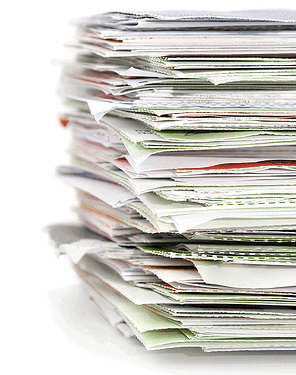How To Design a Service-Oriented Billing Statement In 7 Simple Steps
December 6, 2013 •Brian Watson

 Effective, timely revenue collection is vital to running a successful business. Getting paid (and paid quickly) enables your organization to take decisive action: reinvest in employees and technology, upgrade the products and services you offer, and satisfy the demands of a whole host of relevant stakeholders.
Effective, timely revenue collection is vital to running a successful business. Getting paid (and paid quickly) enables your organization to take decisive action: reinvest in employees and technology, upgrade the products and services you offer, and satisfy the demands of a whole host of relevant stakeholders.
Even in today’s increasingly digital world, for businesses that rely on deferred billing, the engine that drives revenue collection is still usually bill print and mail. For example, according to the 2012 Fiserv Billing Household Survey, only 48% of U.S. consumers receive at least one bill electronically each month.
That means there are still plenty of paper bills being sent to consumers and business every day. And that, when it comes to revenue cycle operations, traditional statement print and mail is still plenty important.
Far more than just ink-on-paper, clean, clear, well-designed billing – whether it’s an account statement, billing invoice, or past-due letter – is truly mission-critical stuff.
Good bills keep your revenue cycle running smoothly and your bottom line awash in cash. On the other hand, poorly designed, inefficiently executed financial correspondence can be a pretty serious accounts receivable liability, leading to higher collection costs, more bad debt, and less cash flow on hand for day-in, day-out business activities.
Not to mention that, like a great joke with a badly mangled punchline, it can be the source of customer confusion and frustration that quickly turns a pleasant transaction into a negative experience.
In this excerpt from our free-to-download statement design whitepaper, Building a Better Bill: Why Good Statement Design Matters (And How You Can Get It), learn why service oriented statements are an important part of any best-class statement processing program.
What’s a Service-Oriented Statement?
In an ideal scenario, your statements pass their penultimate test with something resembling flying-colors: the customer receives an accurate bill in a timely manner, is easily able to understand its contents, and promptly takes action to pay the balance due. Your service staff isn’t further burned by excessive customer phone calls. It all works swimmingly and everything seems right with the world.
Unfortunately, truly absolute absolutes are really hard to find. Inevitably, even the best designed bills – those that pay careful attention to length, language used, and readability – simply won’t get the job done from time to time.
That’s why it’s so essential that you’ve planned for just that kind of contingency. And that the result of your diligence provides customers with multiple ways to answer their question – everything from clearly marked support phone numbers, to a URL for online instructions, to a brief-but-informative billing FAQ enclosed with the statement.
A customer service number buried on the form isn’t enough. Not when cash flow delays and hard-won customer satisfaction and loyalty are in jeopardy.
Step 1: Billing FAQ
If you’re like most businesses, your customer support staff probably receives many of the same billing questions over and over again from customers. That’s helpful from a troubleshooting standpoint – it’s easier to answer common issues than really unique ones – but it’s also a tedious and inefficient for both your staff and its customers.
The best way to quickly and easily resolve billing issues is by using the available space on your statements to provide customers with the information and resources they need to better understand what they’re being asked to pay and why.
Service-oriented statements don’t just pass the buck with a phone number or web address. They anticipate questions – leveraging what you know about your customers and their most common billing issues – and provide fast, effective answers.
For example, incorporating a list of Frequently Asked Questions into your statement package helps use the customer support information you’ve accumulated to head-off common issues before they become an expensive, time-consuming support call. Or the reason why a customer is delaying (or outright refusing) payment.
However, when creating a statement FAQ, it’s important to pay careful attention to size and scope. To keep your list manageable, we suggest limiting your FAQ to 3-5 of your most pressing customer billing questions.
That enables you to provide customers with valuable answers and instructions, while still ensuring that your statement design remains clean, clear, and readable. Too many questions or long, drawn-out answers can clutter your design – confusing customers and detracting from statement effectiveness. While adding additional pages helps maintain design readability but can quickly increase collection costs.
Step 2: Customizable Contact Information
Variably-imaged, user-specific contact information on each page of the statement can be used to tell customers exactly where to call if there is a billing question or problem.
Step 3: Billing Glossary
A glossary of key billing terms is a simple, space-conscious way to ensure your customers know exactly what is being asked of them on their statement.
Step 4: Information Updates
No matter how hard you try, customer information can become out of date quickly. That slows your revenue cycle and keeps customers from receiving the account-related information they need. An easy-to-use form on the payment stub is an extremely low-impact solution – enabling customers to update outdated or incorrect contact and/or insurance information.
Step 5: Integrate Online Support
Add links to an online billing center that provides in-depth help and discussion of your financial assistance programs.
Step 6: Payment Channels
Don't assume your customers know about your online billing channel. Or what number to call to make a voice-based payment. Include a full list of all the channels you offer customers to help them pay their outstanding balance – everything from paying and remitting their paper statement stub to accessing cutting-edge tools like a mobile billing application or online payment portal.
Step 7: Easy Payment Processing
Make payment processing easy on your staff. Add a scan line that automatically transfers payments to your lockbox. Or print key customer account information on the statement payment stub – like a customer, patient, or transaction number – to allow business office employees to process payments using only the portion of the bill remitted by the customer.
Want to learn four more critical statement design steps on the path to revenue cycle nirvana? Click here to download your free copy of our billing best-practices whitepaper, Building a Better Bill: Why Good Statement Design Matters (And How You Can Get It).
Get Updates
Featured Articles
Categories
- Charity Care Management (1)
- Compliance (2)
- Customer Service (8)
- Digital Front Door (1)
- Direct Mail (6)
- eBilling (1)
- EBPP (34)
- ESL Statement (2)
- eStatement (1)
- Healthcare Channel Partner Billing (1)
- IVR (3)
- Mobile Payment (11)
- Online Billing and Payment (6)
- Online Patient Payment (17)
- Outsource Print Management (4)
- Paperless Billing (4)
- Patient Engagement (2)
- Patient Friendly Billing (21)
- Print and Mail (7)
- QR Codes (1)
- Quick Pay (7)
- Security (1)
- Self-Pay Patients (9)
- Self-Pay Revenue (4)
- Statement Design (32)
- Statement Print and Mail (1)
- Statement Printing and Mailing (28)
- Statement Processing (36)
- TransPromo (1)
- Up-Front Billing (1)

